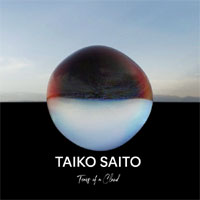Taiko Saito • Tears of a Cloud
Ms. Saito was born in Sapporo, Japan in 1976. At age 21, having studied both marimba and percussion for almost a decade with marimba master Keiko Abe at the Toho School of Music, she moved to Berlin to study vibraphone and composition at the Universität der Künste Berlin with David Friedman. Six years later she cofounded the marimba/vibraphone-piano duo Koko with German pianist Niko Meinhold. Their self-titled debut album was released on CD in 2006 on the Pirouet label (a self-released album featuring Koko, recorded live in Bogotá, Columbia, was released in 2016.) In 2007, along with late percussionist Rupert Stamm, she created the duo Patema, which issued the album Mokoton on the Zerozero label. Other projects include the Berlin Mallet Group of which she was a founding member, and a contribution to the soundtrack to the 2010 movie Ashes To Honey, directed by Hitomi Kamanaka. Her discography, as featured soloist or otherwise, extends to over 24 releases, Tears of a Cloud being her latest. It opens with the aggressive, intense and driving “Daichi,” which serves as a delightful precursor of things to come. There’s no holding back on the dynamics here, as Saito demonstrates her mastery of the marimba. The listener is treated to the myriad sounds and textures she coaxes from the instrument’s Honduras Rosewood bars with her own handmade, leather-tipped mallets. The lithe “Rain” follows and begins quietly, resembling raindrops falling on nearby leaves. It is not a storm but a steady, heavy drizzle. The intensity of the patter increases to a climax and then recedes into calm as the cut ends. Next, “Angry Bee” sounds just as you would expect from its title. Focusing on the upper octaves of her instrument and demonstrating amazing stick control, Saito deftly imitates the flitting about of sound as if a bee had transducers on its wings. Closing side one, “Tears of a Cloud” introduces the vibraphone, as its metal bars, pedals, resonators and motor-driven rotating discs create shimmering points of sound permeating the near silence of the soundscape. The effect is as close to floating as one can get with sound alone. Side two opens with “Sound Gradation,” performed on the marimba. The listener is teased with the sound playing hide and seek, growing in intensity with an insistent rhythmic pattern that defines the piece as it ebbs and flows towards a turbulent ending. This piece would not be out of place on a program of Steve Reich’s minimalist music. “Uneri” follows, the piece opening ominously, with a somber mood prevailing until an agitated moment explodes into a frenzy of sound. If I correctly Googled the word uneri, it can mean surging waves or a ghostly dragon. I prefer the second interpretation here. Eerie, unconventional sounds, created with soft mallets and a double-bass bow(!), define the next piece, “Underground.” After a few truly creepy moments, the tension increases until a few swift, solid mallet strokes end the piece. “Distance” closes the album on a mellifluous note, as the drifting sound of the vibraphone is used to good effect as it chimes in melodious sound. This piece is perhaps the most accessible on the album. The vinyl is flat, heavy and relatively quiet, with no visible imperfections, and it played fine. The recording is close enough to capture each nuance of the performance, such as the impact of the tip of the mallet on the bars and the action of the vibraphone’s sustain pedal, and throaty sound of the five-and-a-half-octave Korogi marimba she plays, yet not so close as to lose the room ambiance. Such details contribute to the sense of realness of the event. The recording is also extremely dynamic and will put your system, especially your phono cartridge, to the test. How best to describe an album that can be used both as a
superb test/demo record and one that can extend your musical sphere outward? It is
probably unlike anything you’ve heard before and, for many of us, it will be a unique
addition to a music collection. Aside from the fact of its sonic acuity, the music etched
into the grooves and set free by the stylus might leave you with an urge to upgrade your
system. |

 y the time you read this, marimba and vibraphone
wizard Taiko Saito will have been awarded the Jazzpreis Berlin 2023 from Der Rundfunk
Berlin-rbbKultur and the Senate Department for Culture and Social Cohesion. This
prestigious ceremony, held on July 3rd in radio station rbbKultur’s Berlin studios,
features the 47-year-old musician in concert and awards her a monetary prize of
€15,000.
y the time you read this, marimba and vibraphone
wizard Taiko Saito will have been awarded the Jazzpreis Berlin 2023 from Der Rundfunk
Berlin-rbbKultur and the Senate Department for Culture and Social Cohesion. This
prestigious ceremony, held on July 3rd in radio station rbbKultur’s Berlin studios,
features the 47-year-old musician in concert and awards her a monetary prize of
€15,000.